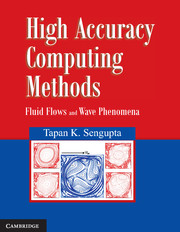Book contents
- Frontmatter
- Contents
- Foreward
- Preface
- Chapter 1 Basic Ideas of Scientific Computing
- Chapter 2 Governing Equations in Fluid Mechanics
- Chapter 3 Classification of Quasi-Linear Partial Differential Equations
- Chapter 4 Waves and Space–Time Dependence in Computing
- Chapter 5 Spatial and Temporal Discretizations of Partial Differential Equations
- Chapter 6 Solution Methods for Parabolic Partial Differential Equations
- Chapter 7 Solution Methods for Elliptic Partial Differential Equations
- Chapter 8 Solution of Hyperbolic PDEs: Signal and Error Propagation
- Chapter 9 Curvilinear Coordinate and Grid Generation
- Chapter 10 Spectral Analysis of Numerical Schemes and Aliasing Error
- Chapter 11 Higher Accuracy Methods
- Chapter 12 Introduction to Finite Volume and Finite Element Methods
- Chapter 13 Solution of Navier–Stokes Equation
- Chapter 14 Recent Developments in Discrete Finite Difference Computing
- Exercises
- References
- Index
Chapter 9 - Curvilinear Coordinate and Grid Generation
Published online by Cambridge University Press: 05 January 2014
- Frontmatter
- Contents
- Foreward
- Preface
- Chapter 1 Basic Ideas of Scientific Computing
- Chapter 2 Governing Equations in Fluid Mechanics
- Chapter 3 Classification of Quasi-Linear Partial Differential Equations
- Chapter 4 Waves and Space–Time Dependence in Computing
- Chapter 5 Spatial and Temporal Discretizations of Partial Differential Equations
- Chapter 6 Solution Methods for Parabolic Partial Differential Equations
- Chapter 7 Solution Methods for Elliptic Partial Differential Equations
- Chapter 8 Solution of Hyperbolic PDEs: Signal and Error Propagation
- Chapter 9 Curvilinear Coordinate and Grid Generation
- Chapter 10 Spectral Analysis of Numerical Schemes and Aliasing Error
- Chapter 11 Higher Accuracy Methods
- Chapter 12 Introduction to Finite Volume and Finite Element Methods
- Chapter 13 Solution of Navier–Stokes Equation
- Chapter 14 Recent Developments in Discrete Finite Difference Computing
- Exercises
- References
- Index
Summary
Introduction
To solve governing equation of motions, we need to resolve all the excited length and time scales. However, even to solve flow past a flat plate, if one takes uniform grid to accommodate the smallest energy carrying length scales, one would be forced to take too many grid points. Numerical solution of the Euler and Navier–Stokes equations for external flow problems requires an outer boundary far away, where some asymptotic boundary conditions apply. This also adds larger requirement on the grid points. Such large problems are poorly convergent and hence, not within the range of the available resources of prevalent high performance computing platforms. This is circumvented by using non-uniform grids. For example, we may decide to take finer grids inside the shear layer (or within the inner layer of a turbulent boundary layer), and take fewer points in the inviscid part of the flow. With nonuniform grids in the physical plane, we usually transform the governing equation in the computational plane, where the spacing is uniform. This also makes writing a code much easier, because of the uniform grid in transformed plane. One needs to write a single code for the transformed plane problem, and for flow past different geometries, one uses the same code provided one can generate a grid mapping from the physical to the transformed plane. Thus, the main solver is grid-independent, and all one needs to do is to generate an appropriate grid transformation either analytically or numerically.
- Type
- Chapter
- Information
- High Accuracy Computing MethodsFluid Flows and Wave Phenomena, pp. 150 - 195Publisher: Cambridge University PressPrint publication year: 2013



